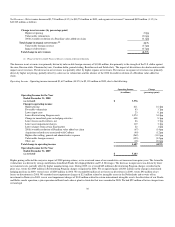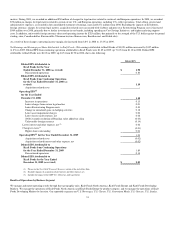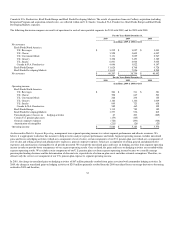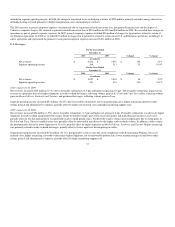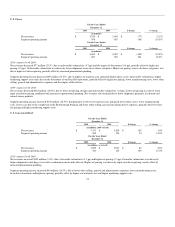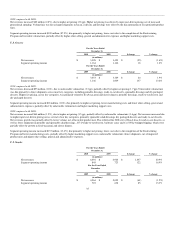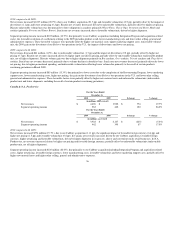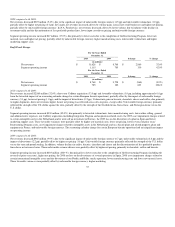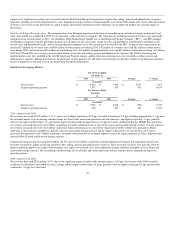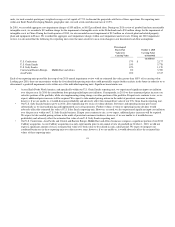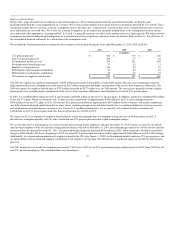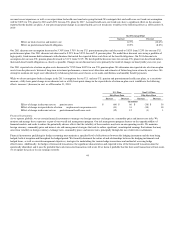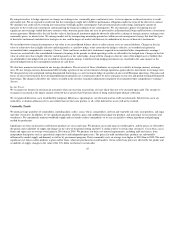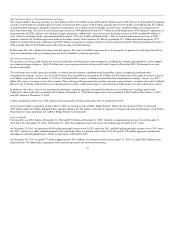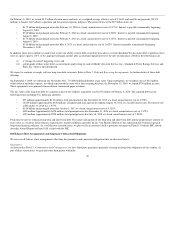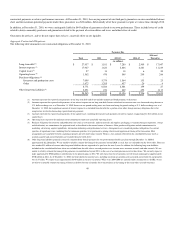Kraft 2010 Annual Report Download - page 43
Download and view the complete annual report
Please find page 43 of the 2010 Kraft annual report below. You can navigate through the pages in the report by either clicking on the pages listed below, or by using the keyword search tool below to find specific information within the annual report.
results two weeks prior to the last Saturday of the period, and certain of our operations in Asia Pacific and Latin America report results through the last day of
the period. We believe the change is preferable and will improve financial reporting by better matching the close dates of the operating subsidiaries within our
Kraft Foods Europe segment and those operations with Asia Pacific and Latin America with our consolidated reporting. This change resulted in a favorable
impact to net revenues of approximately $200 million and an insignificant impact on operating income and net income in 2010. As the impacts to prior period
results were not material to our financial results, we have not revised the prior period results for this change. Our domestic operating subsidiaries will continue
to report period-end results as of the Saturday closest to the end of each period, and our international operating subsidiaries will continue to report period-end
results two weeks prior to the Saturday closest to the end of each period.
We account for investments in which we exercise significant influence (20% - 50% ownership interest) under the equity method of accounting. We use the
cost method of accounting for investments in which we have an ownership interest of less than 20% and in which we do not exercise significant influence.
Noncontrolling interest in subsidiaries consists of the equity interest of noncontrolling investors in consolidated subsidiaries of Kraft Foods. All intercompany
transactions are eliminated.
Use of Estimates:
We prepare our financial statements in accordance with U.S. GAAP, which requires us to make estimates and assumptions that affect a number of amounts in
our financial statements. Significant accounting policy elections, estimates and assumptions include, among others, pension and benefit plan assumptions,
lives and valuation assumptions of goodwill and intangible assets, marketing programs and income taxes. We base our estimates on historical experience and
other assumptions that we believe are reasonable. If actual amounts differ from estimates, we include the revisions in our consolidated results of operations in
the period in which we know the actual amounts. Historically, the aggregate differences, if any, between our estimates and actual amounts in any year have
not had a significant impact on our consolidated financial statements.
Inventories:
Inventories are stated at the lower of cost or market. We value all our inventories using the average cost method. We also record inventory allowances for
overstocked and obsolete inventories due to ingredient and packaging changes.
Long-Lived Assets:
We review long-lived assets, including amortizable intangible assets, for impairment when conditions exist that indicate the carrying amount of the assets may
not be fully recoverable. We perform undiscounted operating cash flow analyses to determine if an impairment exists. When testing for impairment of assets
held for use, we group assets and liabilities at the lowest level for which cash flows are separately identifiable. If an impairment is determined to exist, the loss
is calculated based on estimated fair value. Impairment losses on assets to be disposed of, if any, are based on the estimated proceeds to be received, less costs
of disposal.
Goodwill and Intangible Assets:
We test goodwill and non-amortizable intangible assets at least annually for impairment. We have recognized goodwill in our reporting units, which are
generally one level below our operating segments. We use a two step process to test goodwill at the reporting unit level. The first step involves a comparison
of the estimated fair value of each reporting unit with its carrying value. Fair value is estimated using discounted cash flows of the reporting unit based on
planned growth rates, and estimates of discount rates and residual values. If the carrying value exceeds the fair value, we must proceed with the second step of
the process. The second step measures the difference between the carrying value and implied fair value of goodwill. To test non-amortizable intangible assets
for impairment, we compare the fair value of the intangible asset with its carrying value. Fair value of non-amortizable intangible assets is determined using
our planned growth rates, and estimates of discount rates and royalty rates. If the carrying value exceeds fair value, the intangible asset is considered impaired
and is reduced to fair value. Definite-lived intangible assets are amortized over their estimated useful lives.
We perform our annual impairment review of goodwill and non-amortizable intangible assets as of October 1 each year. The basis of our valuation
methodology for estimating the fair value of our 21 reporting units is a 20-year projection of discounted cash flows that is based on our annual strategic
planning process. Estimating the fair value of individual reporting units requires us to make assumptions and estimates regarding our future plans, industry
and economic conditions. For reporting units within our Kraft Foods North America and Kraft Foods Europe geographic
40


